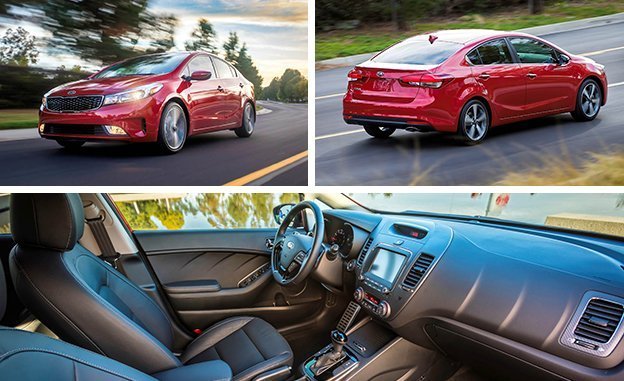We don’t want to repeat “Look at how far Kia has come!” because we’ve all witnessed the company’s impressive transformation. Although, technically, we just said it again. This time the impetus is the newest Forte sedan and Forte5 hatchback, because what compact car just eight years into its life span goes from dull underachiever to spiffy underdog? Now that we’re halfway through the second-generation Forte, a mildly refreshed 2017 model (the updated Koup comes later) adds more dazzle to an already well-dressed and competent small car.
Kia didn’t fuss much with the exterior. If anything, the Forte comes across as less fussy. On both sedan and hatch, the “tiger nose” grille trades its ragged sides for a smoother outline that’s fully flush, with thinner, longer headlight housings that incorporate optional adaptive xenon bulbs. The entire front fascia is new, too. On the sedan, air inlets at the corners push the fog lamps inboard on the lower fascia, in which the mesh pattern is replaced with simpler, horizontal lines. In contrast, the hatch now has a more VW GTI–style look with simple, round fog lamps. Only industrial-design students, automotive journalists, and Kia corporate employees will catch the rear bumper mods on the sedan, which integrate the lower reflectors into the black trim and feature a gentle upward curve from the lower trunk lip to the rear quarters. The sedan taillights keep their budget-Audi appearance and move the turn signals and reverse lights to the lower portions. Kia says it also revised the hatch’s taillights, which we’ll have to trust them on, because it’s tough to spot the difference. The interior remains unchanged, which means it still doesn’t match the refinement of the Mazda 3 or the Volkswagen Golf. Maybe with the next generation.
Fuel Economy: Gets Better and Worse
Kia retired the Forte sedan’s base 1.8-liter four-cylinder engine, replacing it with a 2.0-liter unit running on the efficiency-boosting Atkinson cycle. Horsepower and torque are nearly identical (147 horsepower versus 145; 132 lb-ft, up from 130), as is fuel economy. Almost. With a six-speed automatic, the LX sedan’s EPA city mileage increases from 26 to 29 mpg while the highway figure drops from 39 to 38 mpg. For the EX, which has a more powerful direct-injection 2.0-liter engine (164 horsepower and 151 lb-ft), it’s a similar story. Here, fuel economy drops slightly in the city, going from 25 to 24 mpg, but the highway rating increases, from 33 to 35 mpg. Kia hasn’t yet detailed the output of the range-topping 1.6-liter turbo in the Forte5, but we’ll bet it won’t stray far from the current car’s 201 hp and 195 lb-ft. An optional seven-speed dual-clutch automatic, like that on the Optima, subs in for the six-speed automatic in the Forte5 SX. A six-speed manual is standard in both body styles (in the base-level LX on the sedan, and in the sporty SX on the hatchback). In a bit of bad news for stick-shift fans, the manual sedan’s highway fuel economy drops from 37 to 34 mpg.
Safety and More Standard Things
On Forte sedans, a new S trim slots between the base LX and the top EX, offering a sport-tuned suspension, 16-inch wheels, LED marker lamps, a rear spoiler, chrome exhaust tips, and a leather-wrapped steering wheel and shift knob, plus white contrast stitching on S-specific black cloth upholstery. Forte5 SX models may tempt citrus lovers with a new Orange Color Pack, which brings orange seat inserts and orange stitching. The EX sedan makes several formerly optional features standard, including heated seats, leather, dual-zone automatic climate control, rear air vents, and push-button start with keyless entry. The EX hatch adds LED taillights and approach lighting to its standard-equipment roster. Apple CarPlay and Android Auto are available on all trims but the LX, which has a 4.3-inch conventional display instead of a 7.0-inch touchscreen.
Driver-assistance features make their big debut for 2017. On the Forte5 LX, blind-spot and rear cross-traffic alerts are optional. On the sedan, they’re reserved for the S and EX. Buyers of the S model can get those previous two features along with forward-collision warning, automated braking with pedestrian detection, lane-departure warning, and various other items as part of the Technology package, for $1490. On the EX sedan, these same safety features are bundled with a bunch more items as part of the $4490 Premium Plus package.
Pricing isn’t out for the 2017 Forte5, but we can tell you the 2017 Forte sedan costs $500 more than the 2016 model in manual LX trim, ringing in at $17,340. At $18,350, the automatic LX is $150 less. The new S model, which is automatic only, is $20,050, while the EX with its extra equipment is up by $1210, to $22,050.
Powered by WPeMatico






